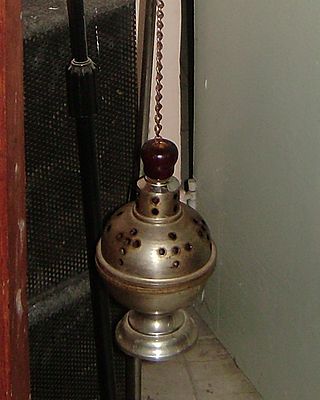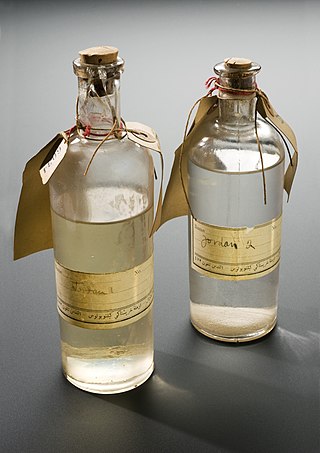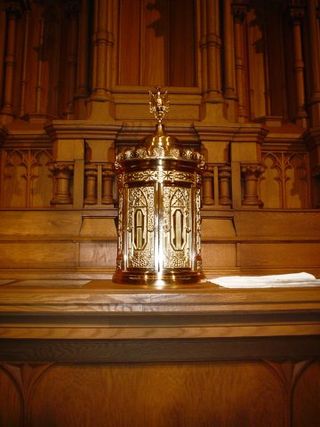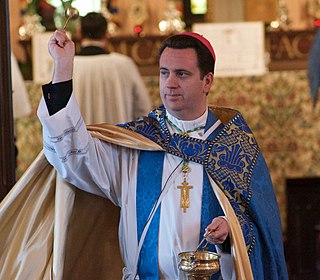
A crucifix is a cross with an image of Jesus on it, as distinct from a bare cross. The representation of Jesus himself on the cross is referred to in English as the corpus. The crucifix emphasizes Jesus' sacrifice, including his death by crucifixion, which Christians believe brought about the redemption of mankind. Most crucifixes portray Jesus on a Latin cross, rather than a Tau cross or a Coptic cross.

Palm Sunday is the Christian moveable feast that falls on the Sunday before Easter. The feast commemorates Christ's triumphal entry into Jerusalem, an event mentioned in each of the four canonical Gospels. Its name originates from the palm branches waved by the crowd to greet and honor Jesus Christ as he entered the city. Palm Sunday marks the first day of Holy Week; in Western Christianity, this is the beginning of the last week of the solemn season of Lent, preceding Eastertide, while in Eastern Christianity, Holy Week commences after the conclusion of Great Lent.

An altar is a table or platform for the presentation of religious offerings, for sacrifices, or for other ritualistic purposes. Altars are found at shrines, temples, churches, and other places of worship. They are used particularly in paganism, Christianity, Buddhism, Hinduism, Judaism, modern paganism, and in certain Islamic communities around Caucasia and Asia Minor. Many historical-medieval faiths also made use of them, including the Roman, Greek, and Norse religions.

Holy Week is the most sacred week in the liturgical year in Christianity. For all Christian traditions, it is a moveable observance. In Eastern Christianity, which also calls it Great Week, it is the week following Great Lent and Lazarus Saturday, starting on the evening of Palm Sunday and concluding on the evening of Great Saturday. In Western Christianity, Holy Week is the sixth and last week of Lent, beginning with Palm Sunday and concluding on Holy Saturday.

A chalice or goblet is a footed cup intended to hold a drink. In religious practice, a chalice is often used for drinking during a ceremony or may carry a certain symbolic meaning.

A thurible is a metal censer suspended from chains, in which incense is burned during worship services. It is used in Christian churches, including the Roman Catholic, Eastern Orthodox, Assyrian Church of the East and Oriental Orthodox, as well as in some Lutheran, Old Catholic, United Methodist, Reformed, Presbyterian Church USA, and Anglican churches. In Roman Catholic, Lutheran, and Anglican churches, the altar server who carries the thurible is called the thurifer. The practice is rooted in the earlier traditions of Judaism dating from the time of the Second Jewish Temple.

Making the sign of the cross, or blessing oneself or crossing oneself, is a ritual blessing made by members of some branches of Christianity. This blessing is made by the tracing of an upright cross or Greek cross across the body with the right hand, often accompanied by spoken or mental recitation of the Trinitarian formula: "In the name of the Father, and of the Son, and of the Holy Spirit. Amen."

Holy water is water that has been blessed by a member of the clergy or a religious figure, or derived from a well or spring considered holy. The use for cleansing prior to a baptism and spiritual cleansing is common in several religions, from Christianity to Sikhism. The use of holy water as a sacramental for protection against evil is common among Lutherans, Anglicans, Roman Catholics, and Eastern Christians.

Chrism, also called myrrh, myron, holy anointing oil, and consecrated oil, is a consecrated oil used in the Catholic, Eastern Orthodox, Oriental Orthodox, Assyrian, Nordic Lutheran, Anglican, and Old Catholic churches in the administration of certain sacraments and ecclesiastical functions.

A sacramental is a sacred sign, a ritual act or a ceremony, which, in a certain imitation of the sacraments, has a spiritual effect and is obtained through the intercession of the Church. Sacramentals surround the sacraments like a wreath and extend them into the everyday life of Christians. Sacramentals are recognised by the Roman Catholic Church, the Eastern Orthodox Church, the Oriental Orthodox Churches, the Church of the East, the Lutheran churches, the Old Catholic Church, the Anglican churches, and Independent Catholic churches.

A tabernacle or a sacrament house is a fixed, locked box in which the Eucharist is stored as part of the "reserved sacrament" rite. A container for the same purpose, which is set directly into a wall, is called an aumbry.

A paten or diskos is a small plate, used during the Mass. It is generally used during the liturgy itself, while the reserved sacrament are stored in the tabernacle in a ciborium.

Asperges is the rite of sprinkling a congregation with holy water. The name comes from the first word in the 9th verse of Psalm 51 in the Latin translation which is sung during the traditional form of the rite except during Eastertide. The 51st Psalm is also one of the antiphons that may be sung in the rite under the Mass of Paul VI.

During the Liturgy of the Eucharist, the second part of the Mass, the elements of bread and wine are considered to have been changed into the veritable Body and Blood of Jesus Christ. The manner in which this occurs is referred to by the term transubstantiation, a theory of St. Thomas Aquinas, in the Roman Catholic Church. Members of the Orthodox, Anglican, and Lutheran communions also believe that Jesus Christ is really and truly present in the bread and wine, but they believe that the way in which this occurs must forever remain a sacred mystery. In many Christian churches, some portion of the consecrated elements is set aside and reserved after the reception of Communion and referred to as the reserved sacrament. The reserved sacrament is usually stored in a tabernacle, a locked cabinet made of precious materials and usually located on, above, or near the high altar. In Western Christianity usually only the Host, from Latin: hostia, meaning "victim", is reserved, except where wine might be kept for the sick who cannot consume a host.

Anglican devotions are private prayers and practices used by Anglican Christians to promote spiritual growth and communion with God. Among members of the Anglican Communion, private devotional habits vary widely, depending on personal preference and on their affiliation with low-church or high-church parishes.

A holy water font or stoup is a vessel containing holy water which is generally placed near the entrance of a church. It is often placed at the base of a crucifix or other Christian art. It is used in Catholic, as well as many Lutheran and Anglican churches, to make the sign of the cross using the holy water upon entrance of the church. Holy water is blessed by a priest or a deacon, and its usage by Christians serves as a reminder of their baptismal vows. The holy water font is a derivative of the cantharus, which has been used by Christians since the time of the early Church to perform ablutions before entering the church.

Among Eastern Orthodox and Eastern-Rite Catholic Christians, holy water is blessed in the church and given to the faithful to drink at home when needed and to bless their homes. In the weeks following the Feast of Epiphany, clergy visit the homes of parishioners and conduct a service of blessing by using the holy water that was blessed on the Feast of Theophany. For baptism, the water is sanctified with a special blessing.

Blessed salt has been used in various forms throughout the history of Christianity. Among early Christians, the savoring of blessed salt often took place along with baptism. In the fourth century, Augustine of Hippo named these practices "visible forms of invisible grace". However, its modern use as a sacramental remains mostly limited to its use with holy water within the Anglican Communion and Roman Catholic Church.

A home altar or family altar is a shrine kept in the home of a Western Christian family used for Christian prayer and family worship. Home altars often contain a cross or crucifix, a copy of the Bible, a breviary and/or other prayer book, a daily devotional, a headcovering, icons of Jesus Christ and prayer beads, among other religious articles specific to the individual's Christian denomination, for example, the images of the saints for Catholics, the Small Catechism for Lutherans, and the Anglican prayer beads for Anglicans.

A cantharus, also known as a phiala, is a fountain used by Christians for ablution before entering a church. These ablutions involve the washing of the hands, face, and feet. The cantharus is traditionally located in the exonarthex of the church. The water emitted by a cantharus is to be running water. The practice of ablutions before prayer and worship in Christianity symbolizes "separation from sins of the spirit and surrender to the Lord." Eusebius recorded this practice of canthari located in the courtyards of churches, for the faithful to wash themselves before entering a Christian house of worship. The practice has its origins Jewish practice of performing ablutions before entering into the presence of God. In the present-day, canthari are found in Eastern Christian and Oriental Christian churches, though in Western Christianity the cantharus gradually transformed into the holy water font.




















